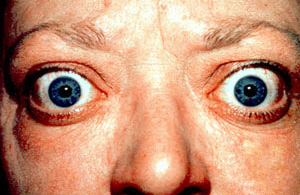Graves disease
Graves' Disease[edit | edit source]
Graves disease:
Definition[edit | edit source]
Grave’s disease is an autoimmune disorder that leads to over activity of the thyroid gland (hyperthyroidism). Grave’s disease is the leading cause of hyperthyroidism and affects 4-5 times more often younger women.
Pathophysiology[edit | edit source]
Grave’s disease is a form of type II hypersensitivity where the immune system makes antibodies called thyroid-stimulating immunoglobin (TSI) that attach to thyroid cells and mimic the actions of thyroid stimulating hormone and stimulate the thyroid to make too much thyroid hormone. The TSI stimulation of TSH receptors in the gland result in hyperplasia or goiter and also increased synthesis of thyroid hormone and especially triiodothyronine (T3). An overabundance of thyroid hormones affect all of the physiologic system such as metabolism, heart function, nervous system, body temperature and more.
Genetics[edit | edit source]
Exact cause of Grave’s disease is not known however genetic factors interacting with environmental factors play a role in the pathogenesis of this disease.
Epidemiology[edit | edit source]
Grave’s disease is most common in women under 40 years old. People with a family history of Grave’s disease or history of other autoimmune diseases have a higher risk of developing Grave’s disease.
Signs and Symptoms[edit | edit source]
- goiter - diffuse, soft, richly vascularized (murmurs may be heard when listening), formation of nodes in elderly patients
- symptoms of thyrotoxicosis
- nervousness, lack of concentration,
- fever, sweating, heat intolerance, weight loss, increased appetite,
- increased sympathetic activation - tachycardia, palpitations, dysrhythmia , hypertension,
- increased GIT motility, diarrhea,
- hyperreflexia, gentle shaking of hands,
- proximal myopathy - muscle weakness and atrophy, especially of the girdle muscles,
- osteoporosis
- endocrine orbitopathy
- swelling of the soft tissues behind the bulb causes exophthalmos,
- activation of sympathetic tone increases m. levator palpebrae sup., severe downward movement of the lids (Von Graefe's sign),
- lagophthalmos (failure to close the eyelids) causes the cornea to dry out and erode,
- eye muscle involvement - diplopia,
- compression of the optic nerve can cause blindness.
- pretibial myxedema - a rare symptom, it is subcutaneous edema with subsequent fibrotization and impaired lymphatic outflow.
- acropachia - swollen swelling of the last parts of the fingers and toes, swelling of the nail beds
Diagnostics[edit | edit source]
- Increased serum values of fT3, fT4, decreased TSH level (standard 0.3−4.2 mIU / l),
- the presence of antibodies against TSH-receptors,
- shortening the reflex of the Achilles tendon,
- thyroid ultrasound (reduced echogenicity) and retroorbital space,
- radioactive iodine uptake test, TSI test.
Differential diagnostics[edit | edit source]
- other causes of hyperthyroidism (e.g. toxic adenoma)
- other causes of bulb protrusion (especially in unilateral to exclude tumor)
Treatment[edit | edit source]
Treatment is aimed at controlling the overactive thyroid. *thyrostatics thiamazole, propylthiouracil block thyroid peroxidase (serious side effect is agranulocytosis, occurring in less than 1 ‰ treated)
- Beta-blockers to alleviate hyperkinetic circulation
- thyroidectomy for thyrostatic intolerance, mechanical oppression and in women planning pregnancy, complications of surgery: removal of the parathyroid glands (hypoparathyroidism), recurrence of the laryngeal nerve
- radioiodine ( 131 I) if surgery is contraindicated
- orbitopathy usually resolves when the goiter is reduced by thyrostatic treatment, but if eye problems worsen, we give corticoids
Links[edit | edit source]
Related Articles[edit | edit source]
External links[edit | edit source]
[PubMed][1] [American Thyroid Association][2] [National Institute of Diabetes and Digestive and Kidney Diseases (NIDDK] [3] [Graves' Disease and Thyroid Foundation][4]
- National Clearinghouse Guidelines. (2011). Hyperthyroidism and other causes of thyrotoxicosis:
Management guidelines of the American Thyroid Association and American Association of Clinical Endocrinologists. Retrieved from http://www.guideline.gov/content.aspx?id=36623&search=grave%27s+disease
- Chiasera, J. M. (2013). Back to the basics: Thyroid gland structure, function and pathology. Clinical
Laboratory Science, 26(2). 112-117
References[edit | edit source]
- American Thyroid Association. (2012). Graves’ disease. Retrieved from
http://www.thyroid.org/what-is-graves-disease/
- Chiasera, J. M. (2013). Back to the basics: Thyroid gland structure, function and pathology. Clinical
Laboratory Science, 26(2). 112-117
- Graves’ Disease and Thyroid Foundation. (2014). About Graves’ disease. Retrieved from
http://www.gdatf.org/about/about-graves-disease/
- McCance, K. L., & Huether, S. E. (2014). Pathophysiology: The biologic basis for disease in adults and
children. St. Louis, MO: Elsevier Mosby
- National Center for Biotechnical Information. (2013). Graves’ disease. Retrieved from
http://www.ncbi.nlm.nih.gov/pubmedhealth/PMH0001398/
- National Clearinghouse Guidelines. (2011). Hyperthyroidism and other causes of thyrotoxicosis:
Management guidelines of the American Thyroid Association and American Association of Clinical Endocrinologists. Retrieved from http://www.guideline.gov/content.aspx?id=36623&search=grave%27s+disease






